When adopting workshop-style teaching and learning, you need a clear plan for how to keep students accountable without drowning in papers to grade. Many teachers ask how I manage grading the work my students complete during Math Workshop each day, and still find time to plan for workshop the following day. The three tools below help me build a clear picture of my students’ progress and needs, keep my students’ parents in the loop about what their child is working on in class, and help me maintain a light load when it comes to grading.
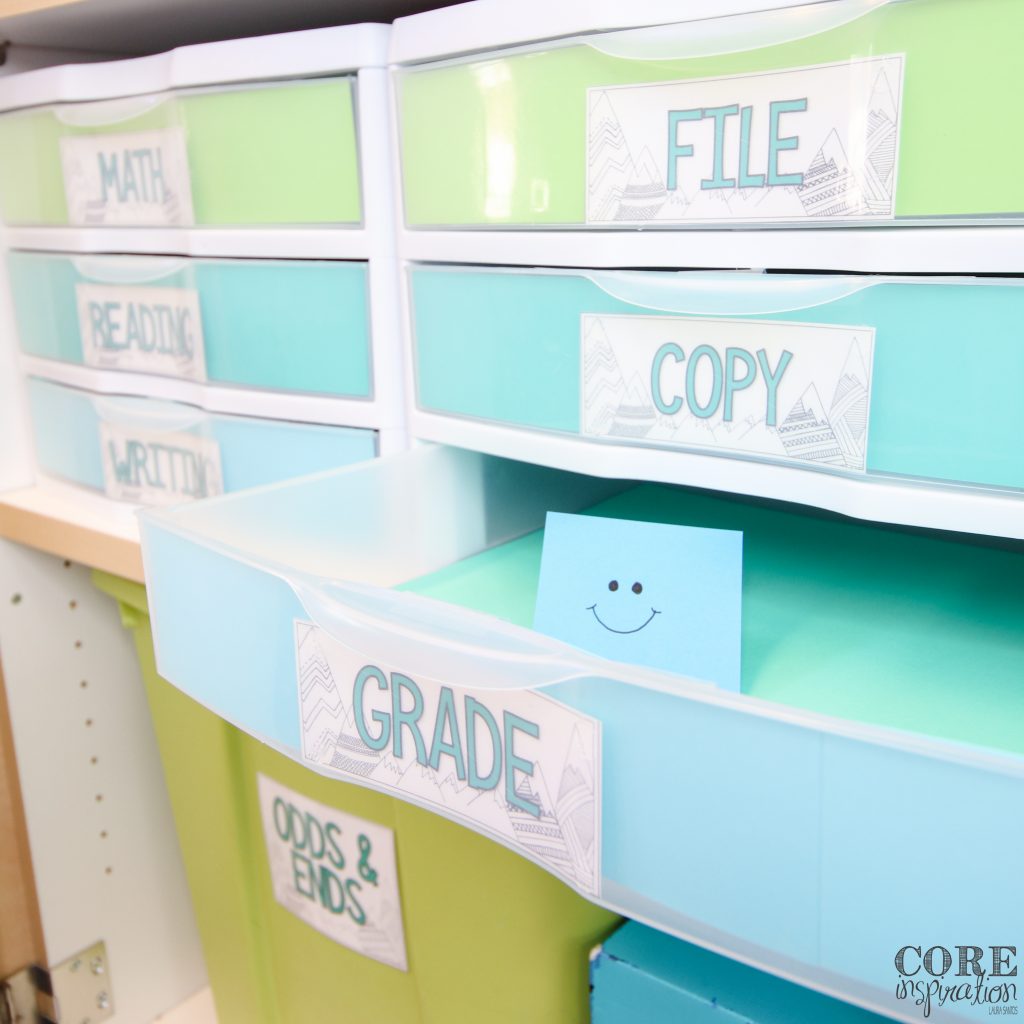
Rubric Drawers
These drawers are my number one time saver. Each week my students are required to complete at least two Problem Solving Task Cards (these in-depth word problems take some time). They submit their completed problem solving recording sheets to these rubric drawers. As they turn in their work, students grade themselves according to our mastery rubric, which is written in student-friendly language on the labels for each drawer.
A good deal of time is spent at the beginning of the year helping students understand the detail and accuracy required for each level of understanding on the mastery rubric. Students’ ability to self-assess accurately is not always strong at the beginning of the year, but grows dramatically with the use of exemplars (explained below) and the consistent celebration of strong student work.
Assessment of Work Habits
At the end of the week, I quickly skim through their submitted work, stamp each paper, and send it home for parents to see. Parents have been informed that a stamped paper is part of our students’ self assessment process, and has only been used as a formative assessment of students’ work habits during workshop that week.
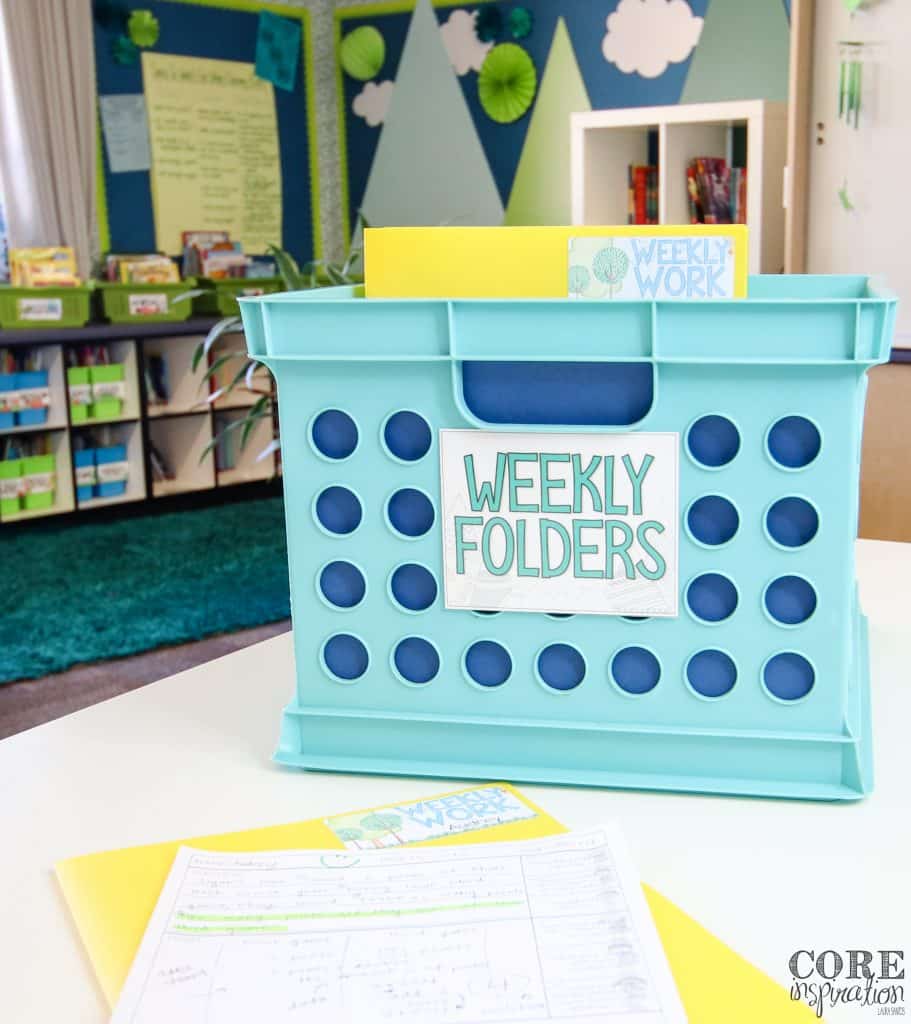
I select two outstanding task cards from the drawers labeled “4” or “3” to display as inspirational exemplars for the following week. This process naturally motivates students to reach higher, dig deeper, and perform their personal best. They take pride in knowing their work may be selected as an inspiration piece for their peers’ work the following week.
Assessment of Understanding
At the top of our rubric drawers is a separate bin. This is where students submit one piece of math work for the week they feel is the strongest representation of their knowledge and effort. Each student is required to submit one piece, which I take the time to grade, share written feedback, and enter into our grade book.
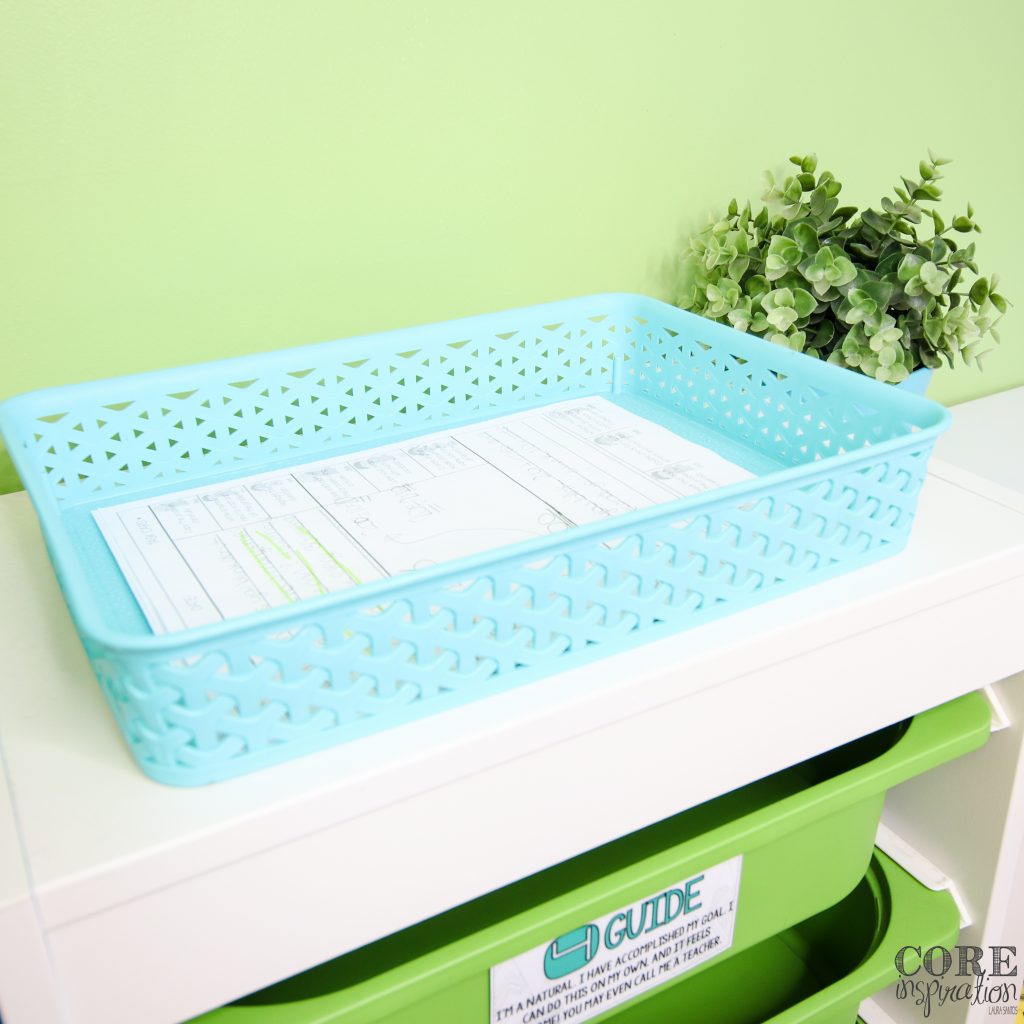
This means there are weeks when I only grade one math paper for each of my students. Using this rubric drawer system frees me from piles of grading, and allows me to spend more time planning engaging activities and lessons that meet the needs of my students. The freed brain power that comes from less grading also help me to be totally present during our workshop block so I can observe students, confer with students, and pull small groups, all while gathering the most up-to-date data about each student’s current level of understanding and needs.
Feedback Cards
Another one of my favorite ways to efficiently keep students accountable, and gather data without having to sit down with a pile of papers to grade is the use of feedback cards. I use these cards when conferring one-on-one with students during M.A.T.H. Workshop, and a modified version during reader’s workshop.
After reviewing a student’s work, or sitting down to support them with problem solving, I make a quick note of their understanding on my data collection sheet and hand them a feedback card with a score of their current level of understanding using the same mastery rubric displayed on our rubric drawers. Then, I leave the student to independently write the justification for their score, and make a quick personal plan for future growth.
Finally, the student staples the feedback card to the paper it corresponds with, and continues working. If the feedback was shared while the student was working on a paperless activity, they write the name of the activity on the back of the card and drop it in their weekly work folder to be sent home. This practice promotes student listening as you meet during workshop, and gives them time to reflect as they quickly write about their learning.
Examplars
One last way I reduce time spent grading is with the use of exemplars. Exemplars are written work samples that demonstrate the different levels of understanding and work quality for a particular task. For example, my students may analyze an exemplar set for a particularly challenging word problem from a recent test. A level 1, 2, 3, and 4 work sample are provided, and we discuss what constitutes each level of understanding. This practice of analyzing work to build a clear picture of what it means to “reach higher” or “go above and beyond” in your learning results in higher student performance and fewer students errors, which makes grading more enjoyable and efficient for teachers.
How To Build A Collection of Exemplars
When starting out, many of your exemplars will be teacher-made. Simply make additional copies of a particular learning task and complete the task multiple times to show multiple levels of work quality and understanding. Below is a teacher-made exemplar set created for a math test.
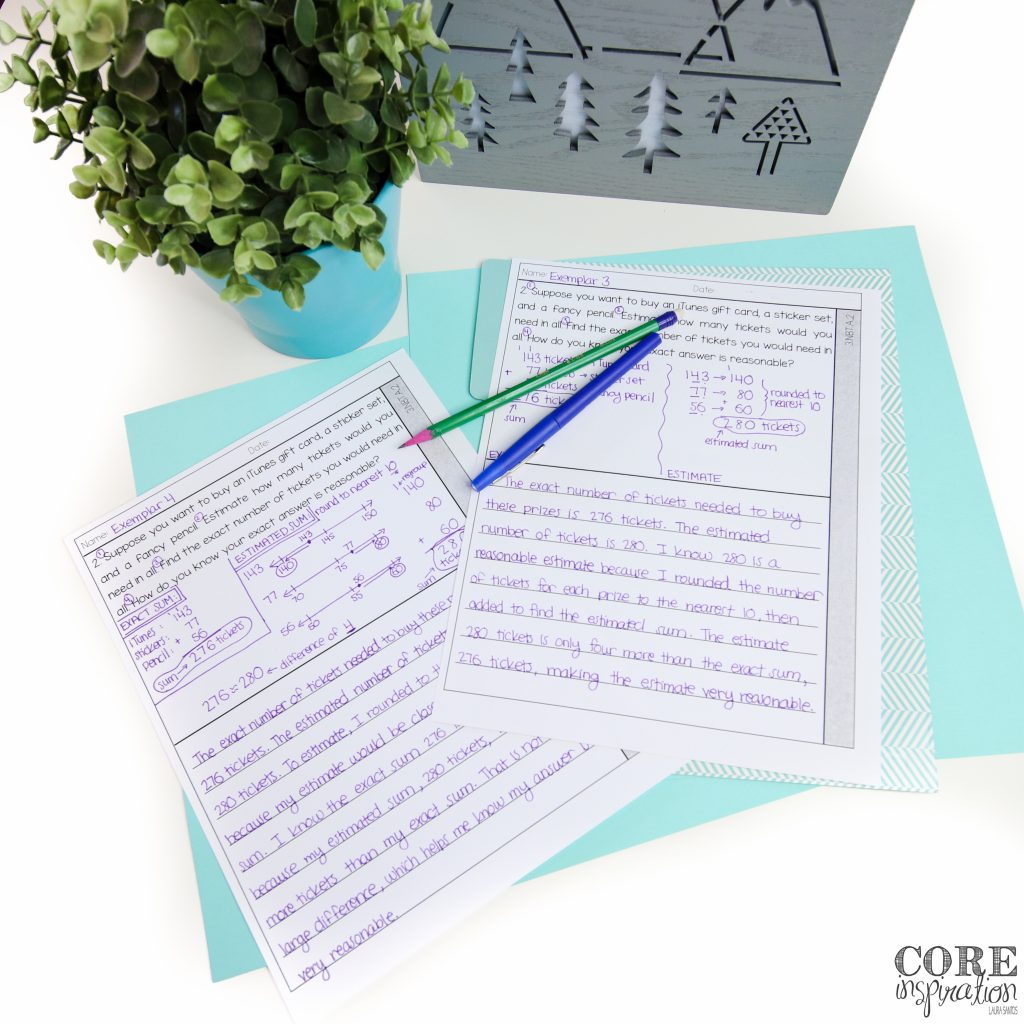
Over time, you can combine your teacher-made exemplars with student-made exemplars. As you grade student work throughout the year, make copies of work that clearly demonstrates each level of understanding for a particular task. Names should always kept confidential on student exemplars. An exception to this may be an inspirational display of high-quality student work that is hung weekly for peers to analyze and admire.
Exemplar-Based Activities
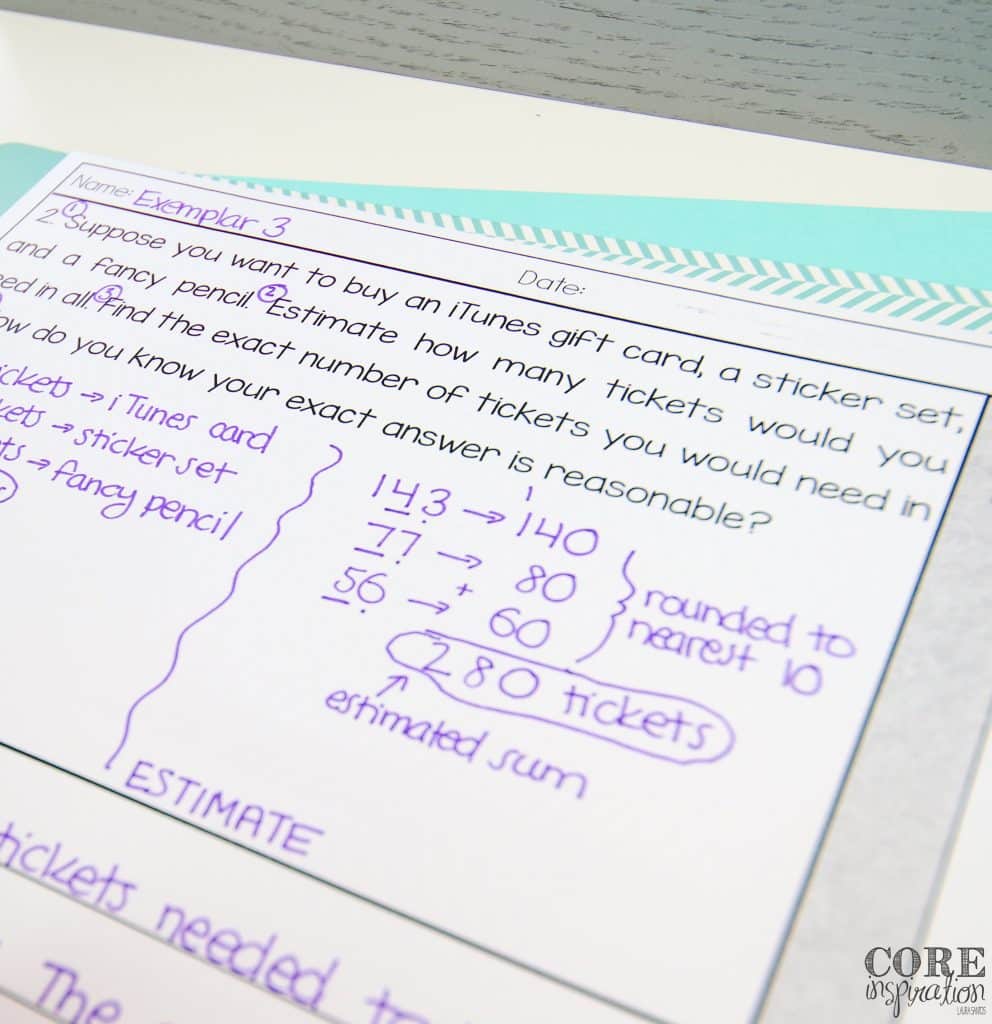
Here are a few exemplar-based activities my third graders enjoy.
You’re The Teacher: Perfect for building a stronger understanding of quality work. Set out a collection of exemplars for a particular math problem. Students get a pad of post-its and travel around the room to read the model, explanation, and final answer for each exemplar. They write their score for each exemplar and their justification for the score, then stick their score on the board next to the exemplar. We then come together to discuss overarching noticings and ah-ha moments that can be applied to future work.
Assessment Upgrade: This activity can be used occasionally, and is perfect if you notice your students were a bit lazy when it came to showing work or explaining reasoning on their most recent assessment. Rather than wasting time grading work you know isn’t the best representation of your students’ understanding, hand the ungraded assessment back to your students. Have them reread their ungraded work and reflect on their performance. Set out a level 4 exemplar for a modified version of the assessment (same concepts, different numbers). Give students a set amount of time to analyze the exemplars before returning to their own work to make improvements.
What Would You Do?: Perfect to help students add more detail to their work. Set out a level 2 or level 3 exemplar. Have students analyze the exemplar and decide what they would do to boost the level of understanding from a 2 to a 3, or from a 3 to a 4. Some guiding questions might be: How would you improve this model? How would you improve this explanation? What changes would you make to strengthen this work? How could this mathematician improve their accuracy? What is missing from this exemplar that would take it to the next level of understanding?
Ready To Spend Less Time Grading?
Less grading may take a little getting used to. In fact, you may feel like you’re slacking with those extra hours you’re about to gain when you implement the systems I’ve suggested. I promise you’ll get over it when you see how much more rapidly your students grow as a result of a more well-rested teacher who actually had time to plan today’s lesson. 🙂

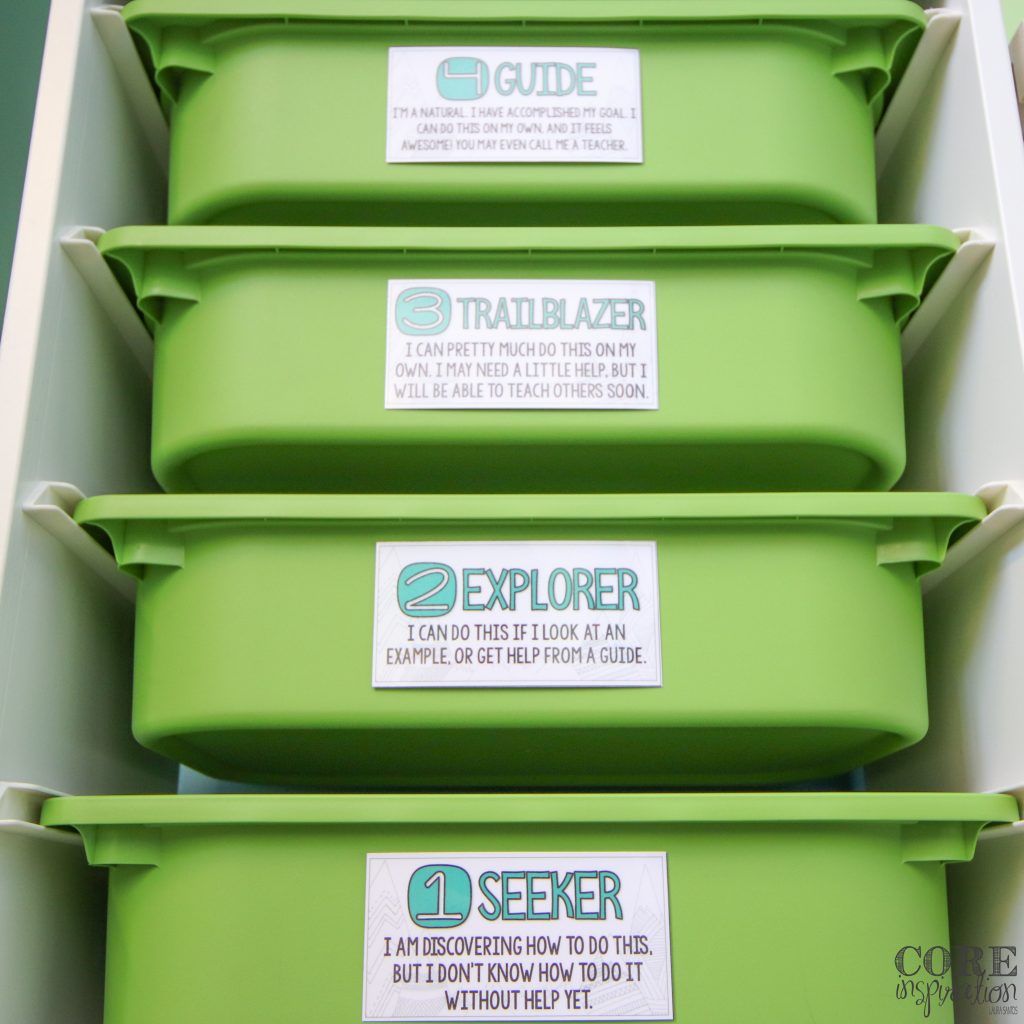
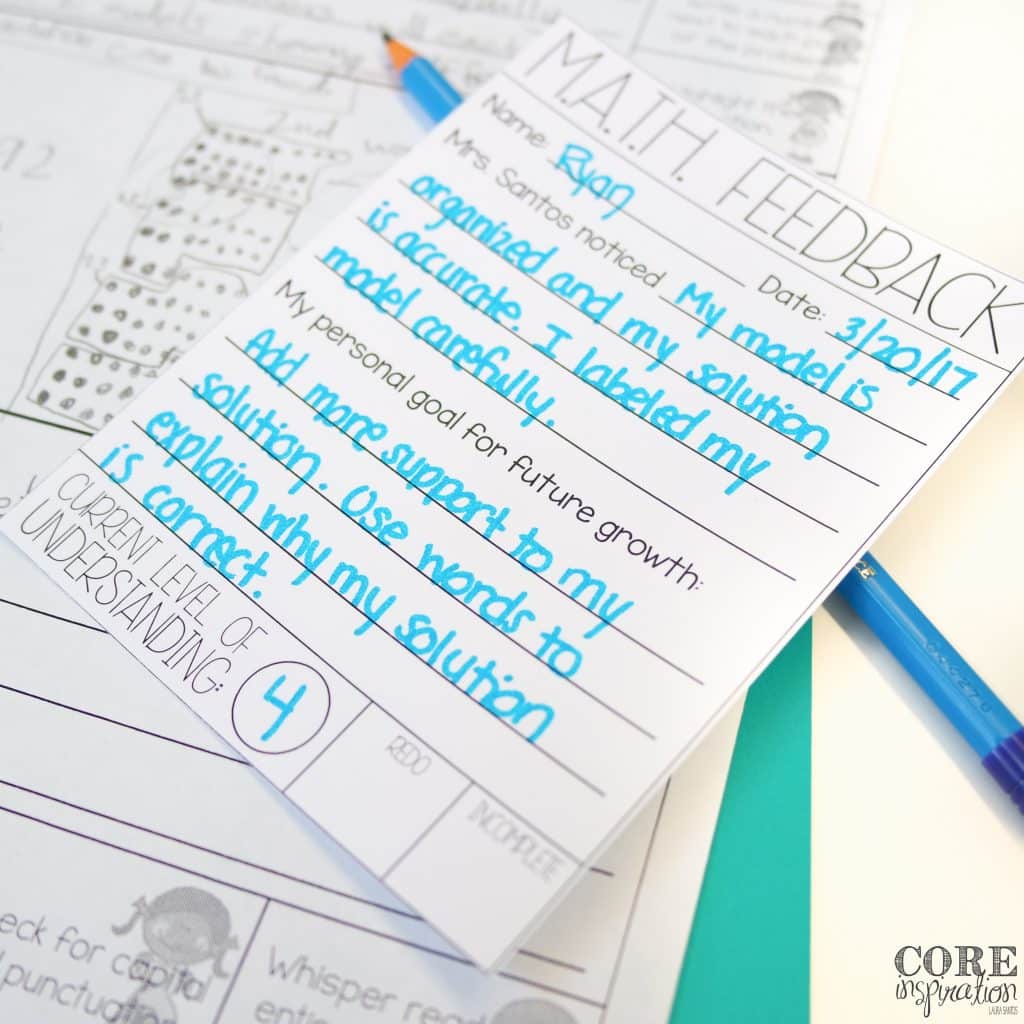

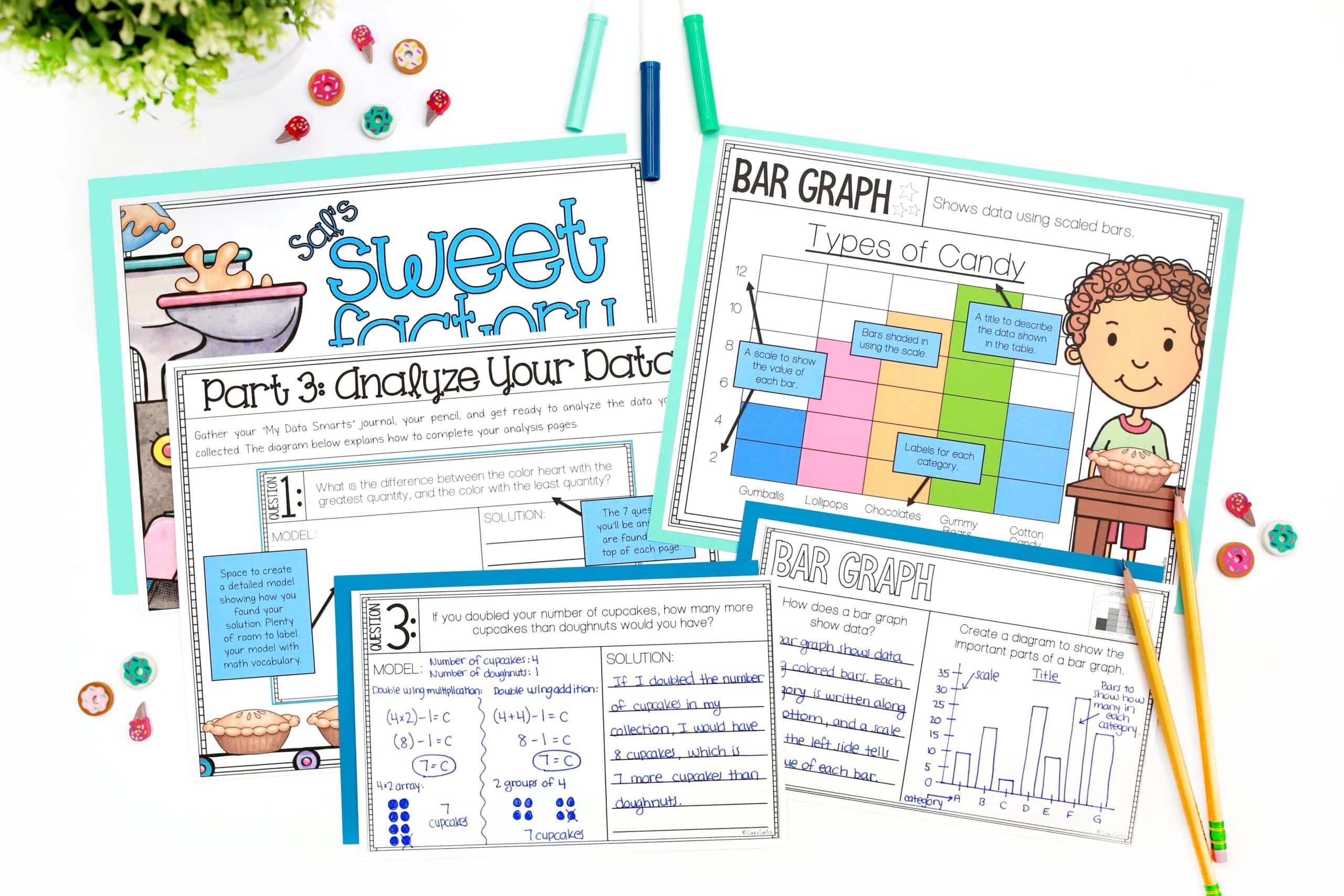
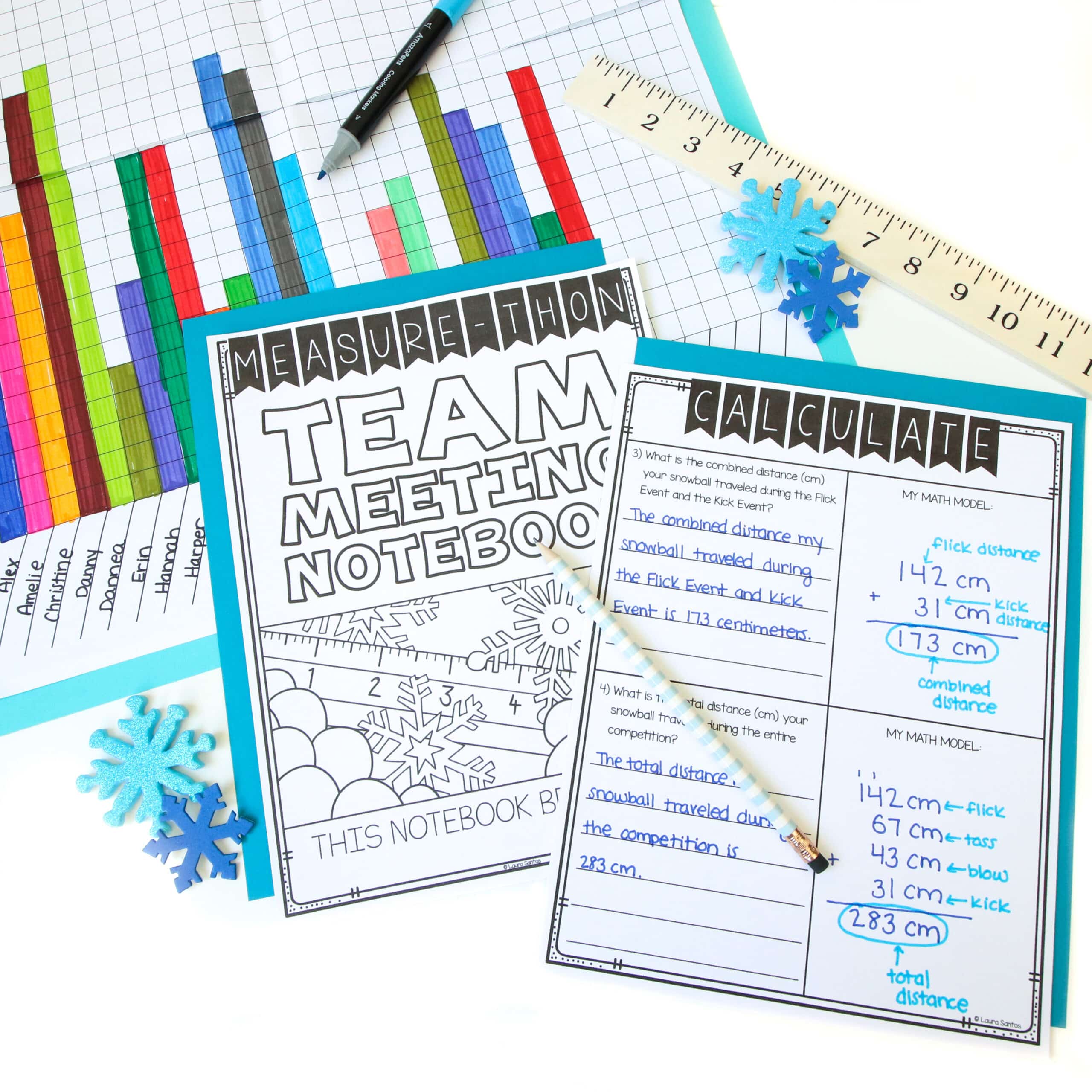

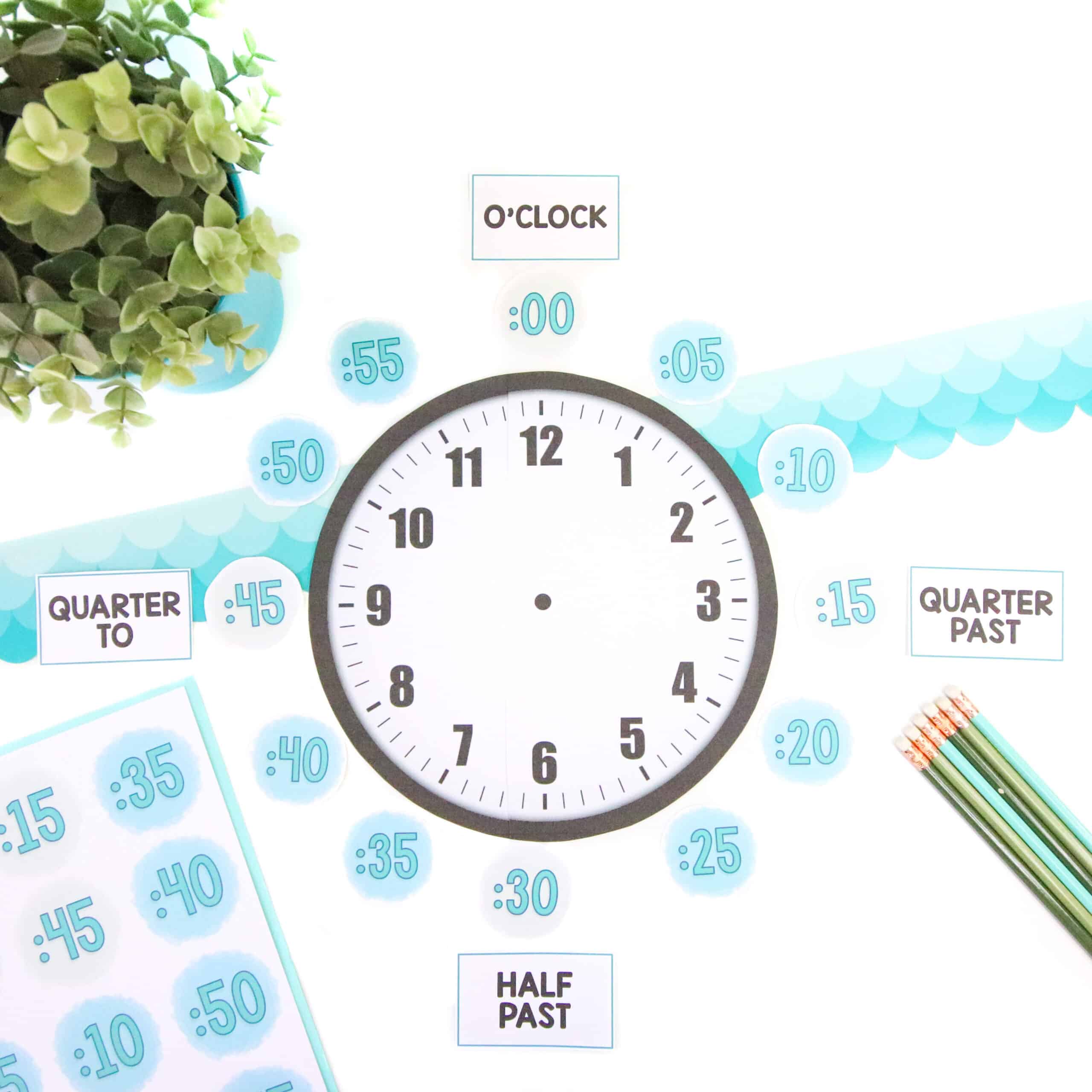
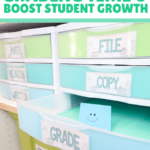
30 Responses
I am really impress! You have a wonderful organization. I teach 3rd grade like You, I’ll be reading your interesting posts. Hopefully I can learn something. Congratulations.
Thank You! Laura
Jamie,
Thank you for taking the time share such a kind note. Wishing you all the best as you finish off your third grade year. 🙂
Warmly,
Laura
This post is amazing! Our district has switched to standards based grading this year and many teachers are struggling to grasp it. I love the rubric drawers and can see how they are helpful. I had a couple questions after reading your post…
Do you stamp their turned in papers with a 1,2,3,4 to let parents know how their child assessed themselves?
Are students only able to turn in task card papers to the top bin or is there other math work that they are able to submit?
Thanks so much! I can’t wait to share this with my team.
Thank you Erin!
Standards based grading is an ongoing work in progress for me. 🙂 I love the idea of stamping the number that corresponds with the students’ self grade so parents can see how students assess themselves. I am definitely getting some number stamps so I can start that. Students are allowed to turn in any math work they feel is the best representation of their understanding. Usually they turn in task cards, but sometimes they are really proud of a model they’ve made on their reteach page (from our math adoption) or a portion of their current PBL unit.
Warmly,
Laura
The math program we use has application problems and exit tickets for every lesson. The exit ticket shows if the student understands the concept that was taught that day, the application is a word problem to prepare the student for the lesson. How would you recommend I use your system? I can’t skip exit tickets because it shows me the students that are struggling each day. So I correct he exit tickets on a daily basis. The application problems are usually done in groups, so I usually don’t grade them. Any advice would help, i want to get students to self assess more.
Thanks!!
Hi Kristin,
Thank you for reaching out. Perhaps you can use feedback cards during the application problem portion of your lesson when students are working in groups. I would have students turn their exit tickets into the rubric drawers based on how they think they performed, and then follow up with your grading. It would be a quick way for them to self-assess each day.
Warmly,
Laura
Our district has been standards based for a while now, but this year we have been provided with a rubric for each standard paired with released questions from previous state assessments. Your post goes along perfectly with our rubrics! I can use the district rubric for the self assessment drawers., and the released questions for the exemplars. Thank you for this post at just the right time!
Hi Jennifer,
That sounds amazing! I wish we had a resource like that in our district. 🙂 Does your district have any of these resources posted online?
Warmly,
Laura
Hello! I am so thankful for this post and all pf your things in TPT. I wanted to know if you sell the exemplar form? I have the task cards and the differentiated math forms, but I would love the one for the exemplars.
Hi Stephanie,
Thank you for reaching out. I do not currently have any exemplars available, but I am so happy to hear there is an interest in them. I will take note of this for my future plans. 🙂
Warmly,
Laura
I am middle and high school math teacher turned elementary school math specialist. I work with our top 60 students (15 per grade level in grades 2-5). These kids exclusively do math with me, and we meet an hour a day, 5 days a week. One of my biggest challenges has been keeping up with the grading and providing substrative feedback. I love this system and I am in the process of implementing it. One question – how do you help kids decide their best piece of work for the week? If they turn in a piece of exceptional work on Monday, do you ever have a kid slack off the rest of the week or want to turn in another exceptional piece? I would love any feedback on helping kids decide their best work. Thanks!!
Hi Lindsay,
Your job sounds like so much fun! I am so pleased to hear you are giving this system a try.
When it comes to helping students select their best piece of work, they are always welcome to change the piece they are most proud of throughout the week if they feel something they complete on a later day is of stronger quality than a piece they submitted on a previous day.
I rarely have the problem with slacking off after submitting a piece early in the week. I think this is due to our school culture, and the consistent focus on being your best self within our classroom community. We talk a lot about the wonderful positive outcomes that result from bringing your all to each learning endeavor, and the negative natural consequences that result from the opposite.
If you want to begin strengthening that class culture, I would highly recommend starting with making an anchor chart as a class that lists the characteristics of “quality work”. Having students create this definition as a community of learners will really help build a foundation for what they’re aiming for. You can always revisit this chart in the first months of implementing this system and add/revise the definition they’ve created together as they’ve had more practice with work selection. I also recommend occasionally having students share with their peers the reasoning behind their “quality work” selection so they can engage in metacognitive practices.
Wishing you and your students all the best!
Warmly,
Laura
Do you still require to prepare a weekly lesson plan in your school wherein differentiation of content, process, and product based on students’ levels? I love to use this M.A.T.H workshop in my class but as a 4th-grade teacher we are departmentalized and in our school, though we used California common core standard, our head requires us to use collaborative learning groups as much as possible. One more thing, I am really interested to apply this in my class.
I’ve learned a lot from you!
Hi Savana,
I do prepare weekly lesson plans based on formative and summative assessment of students’ strengths and needs, but we are not required to submit them weekly to admin. I absolutely encourage you to give this a try with your departmentalized fourth grade configuration. What a wonderful setup that must be! You students must really thrive from the time and planning that results from the work your team is doing. Thank you for taking the time to reach out.
Warmly,
Laura
Laura,
Have you used the rubric drawers with 1st and 2nd graders? If so, did you do anything differently? Any modifications ?
Thanks for a great post!
Rebecca
Hi Rebecca,
I have used them successfully with second graders without any modifications. This month, I have a post coming out with more detail about how my class works together to write the labels for each drawer. Keep you eye out. 🙂
Warmly,
Laura
Hello, you mentioned ELA. Do you use this same model for ELA? I’ve been trying to move towards worksop-type classroom, but struggle with how do I do this with ELA? Are there articles that perhaps inspired you to move towards workshops?
Thank you.
Hi Diane, I recently published a post about how I used student reflection and rubrics for ELA. You can find it here. Most of my workshop inspiration came from other teachers I’ve worked with over the years who used it successfully. 🙂 Donalynn Miller is always a go-to for me when it comes to workshop philosophy, and I love following Literacy For Big Kids on Instagram and Facebook for more inspiration.
Warmly,
Laura
Hi Laura,
In your post you mentioned that you stamp their formative work before it goes in their weekly take home work folder. I am curious- what does the stamp say? Is it a grade or just a note saying that this work was formatively checked and used for instructional purposes?
Thanks,
Jamie
Hi Jamie, I would love for it to be a fancy stamp…what a great idea! Right now it’s just a bumble bee stamp. 🙂
For the papers you don’t grade, do you still look over them after they turn it in to check for understanding or do you check as they are working on it in class (knowing it won’t be graded)? Or do you just quickly stamp and send home?
Hi Christi, I usually check as they are working in class knowing it won’t be grading, then quickly stamp and send home. 🙂
Hi Laura,
I bought your MATH Workshop starter pack and intended to use it at the beginning of the year but things happened and never got it off the ground, we’re on winter break and I want to start fresh with my class and reset and really get it off the ground. Do you have any recommendations? Also, what pre-assessments do you use? I LOVE all your ideas. I teach 5th grade and my district also uses envision math but my team moved away from at first this year and started EngageNY, then sort of went back to Envision (we’re sort of pulling from different areas for curriculum), and have 1:1 laptops and access to iPads.
Thanks!
Karla Hess
Hi Karla, have you read my post about the first and second week of math workshop? Those detail exactly how I roll out workshop when getting started. I like to use a few questions from the open response assessments from envision for pre-assessment. As for tech, I highly recommend Khan Academy especially since you are 1:1. 🙂
Let me know if you have any other questions!
Laura
Hello! I’m hoping you’re still answering questions on this post. I’m headed back to the classroom (4th grade, self contained) after being home for 10 years. I love this system!! My question…since the students turn in their best of the week, you’re getting all different assignments from them to be graded…how do you handle that in your gradebook? The student end makes sense to me, I’m just curious about the logistics end for you as the teacher. Thanks!
Hi Molly,
Thank you for reaching out. Since all the assignments for that week are aligned to the same standard, I create a standards-based assignment for which I can accept any piece of evidence/work and create a grade for. That’s one of the best parts of a differentiated workshop classroom. Students can show evidence of their learning in many different ways. Hope this is helpful as you get your own system organized. 🙂
Warmly,
Laura
Hi, Laura. I’d love to use this idea in my grade six class. Are there any changes you’d recommend for that?
Thanks!
Thank you, Laura, for another great blog. I’ve used this method (successfully) in previous years. Everyone should give it a try! My concern with this year’s class is they just don’t care; they are very unmotivated. I have thirty 3rd graders. Twenty are boys and only 10 students are interested in learning and growing. I have exhausted every learning strategy I can think of but I just can’t get them on board. What do you do to get the goof balls on board? And what would you do if, at the end of the week, they had not completed the two task cards or placed anything in the best work basket?
Hi Dana, thank you so much for reaching out. Those years when you have a class with a strong personality can feel very defeating and absolutely exhausting. Your students are so fortunate to have a teacher who keeps trying new strategies to help them make the most of their learning this year! You’re amazing! 🙂
In this case, I would modify the requirement to one task card per week so the process of reflecting feels less overwhelming for them. I know this can be frustrating because deep down you know they have the potential to complete more work, but sometimes slowing it way down, cutting it way back, and taking plenty of time to emphasize that you are here to support them and make things feel manageable helps you all find common ground.
During this process, I also recommend using exemplars to help the class as a whole to develop their work habits and their reflection skills. I’ve written a blog post about the process I use here. At first, you will probably continue to see lots of unengaged leaders who are rushing through this process but finding time to make this a consistent part of your daily or weekly schedule will lead to transformation over time.
Please let me know if you have any follow up questions.